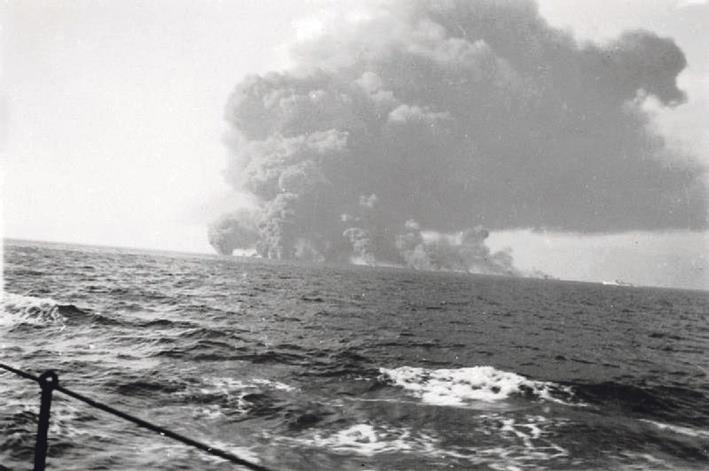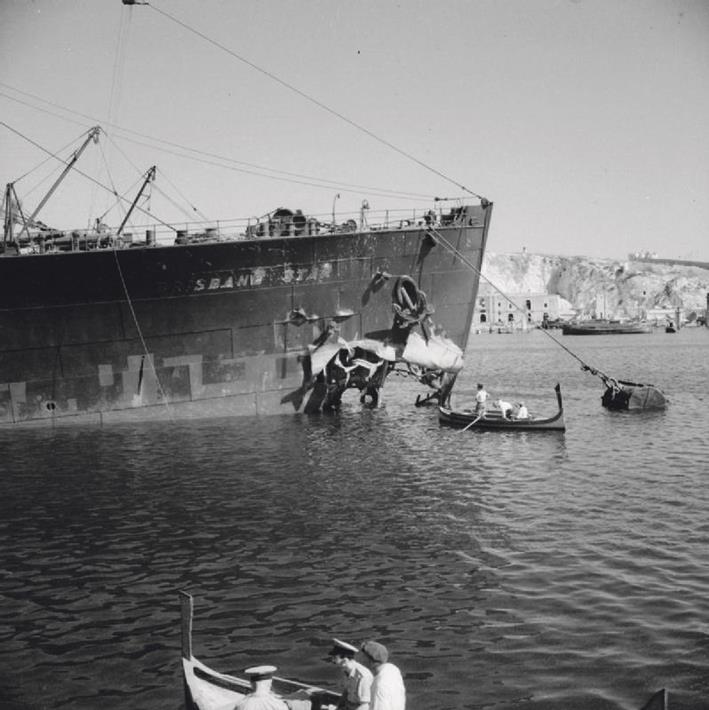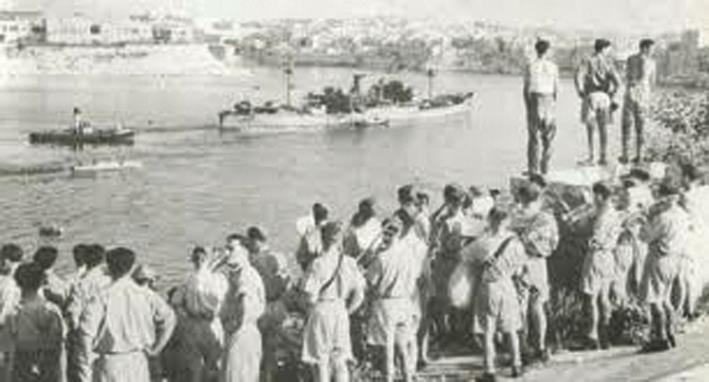The strategic importance of Malta is an intrinsic part of the country’s history. Napoleon Bonaparte, while on his travails in the Mediterranean, had one said that he would prefer to see the British in one of the suburbs of Paris than in Malta. Given the context in the Mediterranean during World War Two – Malta was seen as being just as significant to the British as it was to Napoleon.
British Prime Minister Winston Churchill summed this up perfectly, saying that the loss of Malta would be “a disaster of [the] first magnitude to the British Empire, and probably [would be] fatal in the long run to the defence of the Nile Valley”.
Operation Pedestal was unprecedented in its size: four aircraft carriers, two battleships, seven light cruisers and 32 destroyers – along with a cohort of corvettes and fuelling ships – were tasked with making sure that 14 merchant ships filled to the brim with a variety of supplies made it into Grand Harbour.
Its size was borne out of circumstance: Malta was starving and two previous convoys – Operation Harpoon and Operation Vigorous – had seen just two merchant ships out of 17 arrive on the besieged island.
The importance of the convoy was indicated by the Admiralty. On 10 August 1942 at 8am, as the convoy sailed past Gibraltar, First Lord of the Admiralty Albert Victor Alexander sent a message to the captains of the ships in the convoy, emphasising the need for Malta to remain supplied.
“Before you start on this operation, the First Sea Lord and I are anxious that you should know how grateful the Board of Admiralty are to you for undertaking this difficult task. Malta has for some time been in great danger. It is imperative that she should be kept supplied. These are her critical months, and we cannot fail her. She has stood up to the most violent attack from the air that has ever been made and now she needs our help in continuing the battle. Her courage is worthy of yours”, Alexander told the ship captains.

The message coincided with the time that German reconnaissance aircraft detected the convoy. Indeed the Axis side also knew full well of the importance of the convoy, and were bent on having it stopped as Malta had been a thorn in their supply lines between mainland Europe and North Africa.
To this end, hundreds of aircraft were siphoned off to Sicily and Sardinia – all with the sole aim of destroying the convoy. A message from Reichsmarschall Hermann Goering – the commander in chief of the Luftwaffe – was in fact intercepted by code breakers at Bletchley Park, wherein Goering ordered that the Luftwaffe “will operate with no other thought in mind than the destruction of the British convoy”, before also noting that “the destruction of this convoy is of decisive importance.
The Axis in fact inflicted great losses on the convoy: the aircraft carrier HMS Eagle was the first to be sunk, while the merchant ships Deucalion, Empire Hope, Clan Ferguson – a veteran of 11 Malta convoys, Wairangi, Almeria Lykes, Glenorchy and Santa Elisa were all sunk. The merchant ship Dorset also had to be abandoned, while the merchant ship Waimarama – which was carrying aviation fuel on deck – also sustained a direct hit, resulting in an explosion that was so fierce that it sank the ship and took a German bomber out of the air with it.
The merchant ships Rochester Castle, Brisbane Star, Melbourne Star, and Port Chalmers all sustained varying degrees of damage as well. The Brisbane Star in fact had lost part of its bow after being hit by a torpedo, while the Port Chalmers was lucky to catch an aerial torpedo in its paravine.
The mainstay of the convoy was however the tanker Ohio. It had been subjected to an incredible amount of attacks, had been evacuated twice, sported a gaping 35 square metre hole in it, had a crashed German aircraft on deck, had a destroyed rudder, and was only still afloat with the help of four other ships; HMS Rye towing it, HMS Ledbury securing its aft and coaxing it in the right direction, and HMS Penn and HMS Bramham practically lashed to either side of the tanker, acting like two absurdly large surgical splints.
These five remaining merchant ships made it into Grand Harbour, with the Port Chalmers arriving first on August 13, soon followed by the Rochester Castle and the Melbourne Star. The Brisbane Star arrived the day after, while the Ohio – by that time not much more than a sagging wreck – arrived in port on August 15, the day of the feast of the Annunciation of the Virgin Mary, still carrying over 9,000 tonnes of oil and petroleum. The tanker’s arrival was regarded as a miracle, and the convoy soon came to be known as the Santa Marija convoy, reflected the day of the tanker’s arrival.

In any other situation, the amount of losses that the convoy sustained would have been enough for it to be considered a failure – but in the grand scheme of things, it was considered to be anything but.
Churchill himself was in talks with USSR leader Josef Stalin, and had promised that the Red Army would be relieved by an attack on the “soft underbelly” of Europe – Italy. For that attack to be possible though, Churchill saw that Malta had to be retained as a base.
He was kept up to date by the Admiralty on the fate of the convoy – possibly with the abject maritime failures that convoys such as Operation Vigorous or PQ17 in the Arctic had been still fresh in mind.
As the updates filtered in, and even while the Ohio’s fate remained in the balance, Churchill sent Stalin a note admitting that while the losses of the convoy were substantial, sufficient shipping had arrived to justify the cost.
Referring to the proposed invasion of Italy, Churchill concluded: “The enemy will no doubt proclaim this a great victory at sea, and so it would be but for the strategic significance of Malta in view of future plans.”
The sentiments on the Axis side were similar; the arrival of the four merchant ships and the tanker was deemed “unsatisfactory” and a Kriegsmarine report saw the convoy as something which may be the “decisive phase of the struggle for North Africa”.
The Supermarina reached the same conclusion, while General Giuseppe Santoro, the deputy chief of staff of the Regia Aeronautica, wrote that the British had achieved a strategic success by bringing Malta back into action "in the final phase of the struggle in Egypt".
Eberhard Weichold – the liaison officer of the Kriegsmarine at the Regia Marina in Rome – provided an apt summary of how the Axis viewed the outcome of the convoy.
“To the continental observer, the British losses seemed to represent a big victory for the Axis, but in reality the facts were quite different, since it had not been possible to prevent a British force, among which were five merchant vessels, from reaching Valetta”, he wrote.
“Thanks to these new supplies Malta was now capable of fighting for several weeks, or, at a pinch, for several months. The main issue, the danger of air attack on the supply route to North Africa, remained. To achieve this objective no price was too high, and from this point of view the British operation, in spite of all the losses, was not a defeat, but a strategic failure of the first order by the Axis, the repercussions of which will one day be felt...”
Those repercussions were indeed felt; the invasion of Italy – Operation Husky – began less than a year later.

The significance of the convoy was however not just strategic. Tens of thousands of Maltese have suffered through months of hardship and near-starvation, as a result of the Axis resolution to bomb the island into submission.
The suffering of these war hardships brought about a number of personal memories and recollections of those Maltese growing up and living amongst the rubble of the island during what was effectively the Second Siege of Malta. These Maltese, young and old, faced threats of bombardment, starvation and disease, living a life of constant prayer clinging on to hope.
In May 1942 – before the arrival of two merchant ships as part of Operation Harpoon – the bread ration was reduced to three-eighths of a ratal (1 ratal being equivalent to 28 grams). By August, when Pedestal set off, rice, sugar and cooking oil were no longer available, whilst butter and lard rations were reduced to a fourth of a ratal for one person, and half ratal of cheese rations for five to six persons.
Laurence Mizzi, who was eight years old at the time, recalls that the hunger was in actual fact worse than the incessant bombing.
“In my opinion hunger was worse than the bombing. I can believe that those who lost relatives during the war through bombing will take a different view of the situation and I myself would share that view in those circumstances. But the reader has to keep in mind that I am writing this narrative of the war as seen through the eyes of a boy; we could with relative ease evade the bombing by going into the shelters but there was no way of running away from hunger”, he writes in his book Wartime Diary of a Maltese Boy.
Mizzi goes on to recall that food shortages were at their worst in August 1942: “You could see emaciated people wherever you looked, with bones showing through their skins; men tightening belts and women did the same to dresses. I recollect hearing people say that goats were being slaughtered for consumption and there were even rumours going about that cats and dogs were likewise being killed for the same purpose.”
In his memoir he recalls the feast day of the Assumption of the Blessed Virgin Mary, when the Ohio sailed into the Grand Harbour and how it ‘saved the population”.
“I do not remember the welcome given to the relief forces (…) but I certainly remember that within days of its arrival white flour made its appearance in the form of the white loaf which soon replaced the dark brown ration loaf. On first seeing a white loaf I could scarcely believe my eyes…”, Mizzi recalls.
Charles Grech meanwhile was one of those who flocked to Valletta’s bastions to watch the Ohio enter the Grand Harbour. He recalls in his memoir – Raiders Passed: Wartime Recollections of a Maltese Youngster – that the gardens were already crowded with people, waiting anxiously to see whether the tanker would safely enter between the breakwaters and how some actually doubted that the tanker would make it.
“Just after 9:00 am, Ohio was literally carried between the breakwater arms, which seemed to welcome and embrace it. The tanker was still being supported by the two destroyers, one on each side, and nursed into harbour by tugboats”, he wrote.
“The crowds on the bastions at first were silent. Then they exploded into an orgy of cheering, clapping, shouting and waving of Maltese flags and Union Jacks, to the accompaniment of the military band, playing from the Lower Barrakka bastion. Their hearts went out to the heroes of the Ohio, who had been close to death a hundred times and had only been egged on by the courage and determination shown by the skipper Captain Mason.”
Grech goes on to say that after the arrival of the convoy things changed drastically in Malta, highlighting that the population now could look towards their future with hope and almost knowing that the worst was over.